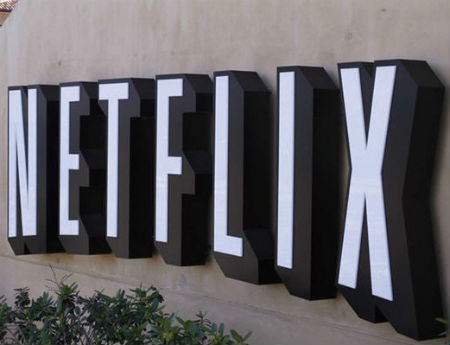Netflix Targets a Positive Cashflow Future
Company says it no longer plans to issue billions of dollars of additional high-yield debt to finance its content splurges

By every useful measure, 2020 was a pretty excellent year for Netflix.
Share prices were up 62% for 2020 (and up 117% after today’s post-earnings spike to nearly $600). Netflix added 37 million subscribers, up 22% to 203.6 million (though perhaps it’s better to think of Netflix’s one year of adds as nearly equal to all of Hulu’s customer base). The Big Red N even brought in more money than it spent, ringing up $25 billion in revenue, up 24%.
That’s all great. Now what?
In 2021, Netflix won’t have much time for a victory lap. The mass of competing subscription or hybrid services continues to grow, with ViacomCBS confirming this week that the rebuilt Paramount Plus goes wide March 4. P+ will join just-launched Discovery Plus and all the other newcomers of the past 15 months in an overstuffed battle for buyers’ attention.
The tussle for viewer attention doesn’t stop there. This week, Fox-owned free, ad-supported service Tubi laid out its own sterling numbers in a piece pitching its charms to advertisers. Among those numbers: 58% growth in watch time in 2020, equaling some 2.5 billion hours, by 33 million monthly active users.
That’s still far less than Netflix, but Tubi is almost certainly not unique in the growing appeal of its free streams of a wide array of pretty good, if not original and new, content. Tubi’s many FAST competitors also are finding lots of value-seeking refugees from the pay-TV bundle.
Together, the FASTs are starting to manifest significant viewership, with improving interfaces and and better ad experiences, providing yet another way for TV viewers to not pay for Netflix.
The smarter way to stay on top of the streaming and OTT industry. Sign up below.
And execs such as Tubi Chief Content Officer Adam Lewinson make a useful point: the history of TV watching has mostly been about free, ad-supported content. Why won’t that be the case in streaming as a broader slice of the populace settles into the future?
Netflix has taken an important step in its long-term financial strategy, announcing it no longer plans to issue billions of dollars of additional high-yield debt to finance its content splurges.
Even better, the company expects to be permanently cash-flow positive by 2022. If it actually can achieve that (the company was cash-flow positive for much of 2020, but expects only to more or less break even in 2021).
That may help quell one source of abiding investor angst, separating any troubling convergence in the trend lines for subscribers, revenue, expenses, and debt. Operating margin is supposed to grow 2 percentage points this year, good, though below the company’s own goals. That still grates on analysts’ nerves.
“It is still hard to gauge the growth rate in program expenses from here,” Northlake Capital Management founder Steven Birenberg told the Observer. “Is there a point where they can drive global sub growth but dramatically slow the growth rate of content spend? There’s so much content now that you would think there is enough not renewed each year that they can just reinvest those savings into originals and there are still enough new shows and movies that subs grow and churn stays low.”
There are reasons for the analysts to chill out. Debt will get paid down to between $10 billion and $15 billion, the company has $8.2 billion in cash, and plans to repay a tranche of bonds coming due Feb. 1 out of cash on hand. Even better, it plans to start returning some money to shareholders, through share buybacks (as if a $600 share price wasn’t enough).
So, the fundamentals of a reliable long-term balance sheet are starting to emerge, not just a giant shell game built on a promise of eventual profits.
More importantly, Netflix is an international company in ways only Disney Plus, among its competitors, is close to emulating.
Already, five in six new Netflix households are overseas, the company said. And it has nearly as many overall subscribers in the Europe-Middle East-Africa region (66.7 million) as the United States and Canada (73.9 million).
“We’re becoming an increasingly global service with 83% of our paid net adds in 2020 coming from outside the UCAN region.,’ says the company’s quarterly investor letter. “Our EMEA region accounted for 41% of our full-year paid net adds, while APAC was the second largest contributor to paid net additions with 9.3m (up 65% year over year).”
That’s a good thing.
It’s worth noting the company’s new marketing campaign highlights its slate of weekly major movies. That compares to the Hollywood giants, who are gingerly busting their long-held distribution windows thanks to the pandemic. The most aggressive of those reshaped plans is HBO Max’s, for a blockbuster every three weeks or so. And WarnerMedia executives still say that’s a one-year plan, though few in Hollywood believe it.
The bigger point, as Disney, WarnerMedia, Apple, Amazon and NBCUniversal tout the blockbusters they’ll bring to their platforms, is that Netflix continues to swamp them all in sheer volume, and often, in significant quality (Q4 awards contenders included Mank, Ma Rainey’s Black Bottom, and The Midnight Sky).
The real big news, though, is how Netflix takes care of all those international viewers, and how its competitors are going to have to evolve if they want to move beyond fighting for a tiny piece of an already saturated U.S. market.
Already, one of Netflix’s biggest shows of 2021 isn’t made in the United States, or even in the English language. It’s the heist series Lupin, a French Netflix original that already has hit No. 2 in the United States.
More importantly, it’s already hit No. 1 in France, Brazil, Italy, Argentina, Vietnam “and many more” of Netflix’s 192 or so territories. The company projects 70 million households will watch Lupin in its first 28 days, one of Netflix’s key metrics tracking the velocity of popularity for new shows. Expect to see more of those kinds of international hits lift Netflix in all the places its U.S. competitors can’t reliably go.
So, the road to the next 200 million subscribers for Netflix doesn’t go through Hollywood, or even Silicon Valley. It’s a path to better balance sheet, with stops in just about every market in the world.
David Bloom of Words & Deeds Media is a Santa Monica, Calif.-based writer, podcaster, and consultant focused on the transformative collision of technology, media and entertainment. Bloom is a senior contributor to numerous publications, and producer/host of the Bloom in Tech podcast. He has taught digital media at USC School of Cinematic Arts, and guest lectures regularly at numerous other universities. Bloom formerly worked for Variety, Deadline, Red Herring, and the Los Angeles Daily News, among other publications; was VP of corporate communications at MGM; and was associate dean and chief communications officer at the USC Marshall School of Business. Bloom graduated with honors from the University of Missouri School of Journalism.

